Traditional Scotch Broth
This post may contain affiliate links. See my disclosure policy.
The quintessential Scottish dish for centuries, Scotch Broth soup is rich, robust, flavorful, and represents everything that is so good about rustic home cooking. Packed with vibrant vegetables, tender barley, split peas, and fork-tender lamb, this hearty and delicious Scotch Broth recipe will nourish both body and soul!

What is Scotch Broth?
Scotch broth is a traditional Scottish soup featuring lamb, barley, split peas, and vegetables. The first time I had this soup was in a small pub outside Inverness in the Scottish Highlands. It was the perfect meal for a cool afternoon and left me feeling happily nourished and rejuvenated, ready for more sightseeing adventures. Once we got home I got work replicating that wonderful dish and it has remained a family favorite ever since.
In her 1856 cookbook, Cook and Housewife’s Manual, Margaret Dods referred to Scotch Broth as the “Pot au Feu of Scotland.” Pot au Feu has also been referred to as “the quintessence of French family cuisine [and] the most celebrated dish in France” so in like manner is reflective of the important place that Scotch Broth has taken at the Scottish family table for centuries. Scotch Broth has been referenced in literature dating back to the 1600’s and it’s popularity has crossed many borders, including the U.S. where the recipe appeared in an 1881 American publication “The Household Cyclopedia.”
The popularity of Scotch Broth has become so widespread that it’s sold in cans in grocery stores and even some of the biggest brands have picked it up. I’ll admit I’ve never had the canned version but what I can tell you is that once you’ve made and tried the real deal you’ll understand why Scotch Broth has been so central to Scottish cuisine.
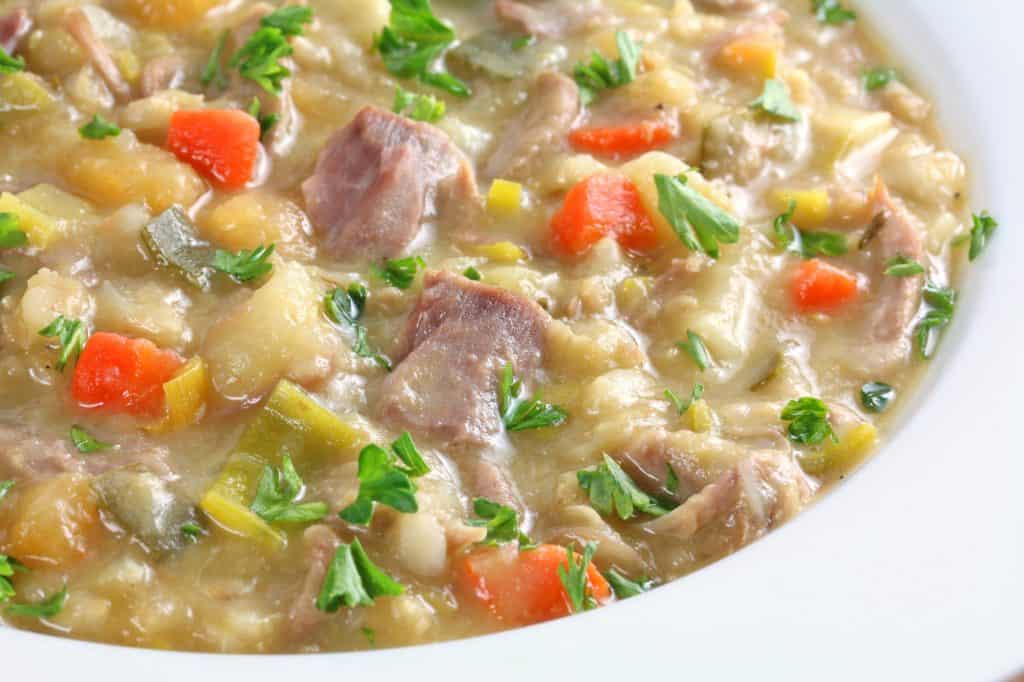
Scoth Broth Ingredients
The term “broth” is a little misleading because more so than a thin liquid that is sipped out of a mug or slurped from a spoon, it is a rich, hearty, thick and satisfying soup – really more of a stew – that has traditionally been eaten as the main meal. It’s loaded with vegetables, some fork-tender meat and generously thickened with barley, split peas and/or regular or red lentils.
Traditionally Scotch Broth would be made from whatever vegetables were in season but these would typically include rutabagas, carrots, turnips, cabbage, and leek. Mutton or lamb is very traditional and imparts an especially rich flavor, but beef may also be used. And if you have some bones to add to the pot, all the better.
Rich, robust and flavorful, Scotch Broth represents everything that is good about rustic home cooking. Traditional Scottish housewives, ever thrifty and knowing how to make much of little, knew how to gather up whatever fresh vegetables were available, add them together with lamb, mutton or beef, some barley, split peas and lentils (all staple Scottish ingredients), and simmer the mixture low and slow for hours to achieve a meal that by dinnertime would nourish both body and soul.
And so I present Scotch Broth, “the Pot au Feu of Scotland!”
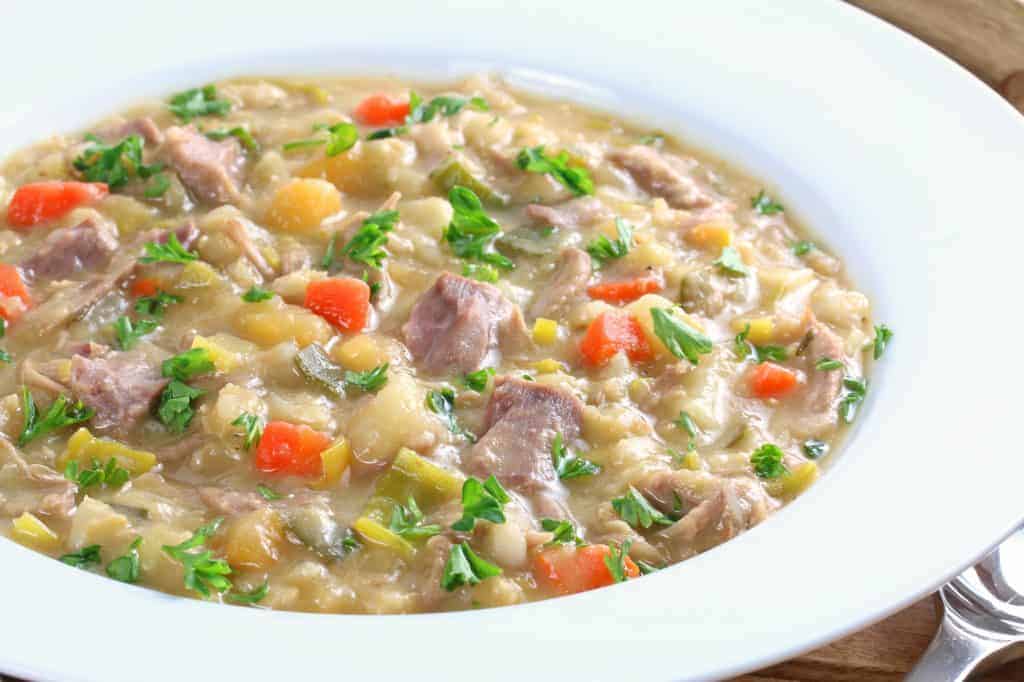
Scotch Broth Recipe
Let’s get started!
For a wonderfully flavor-packed Scotch Broth, we’re going to use leek, carrots, onions, rutabagas, turnips and parsnips. Get those cleaned and diced.
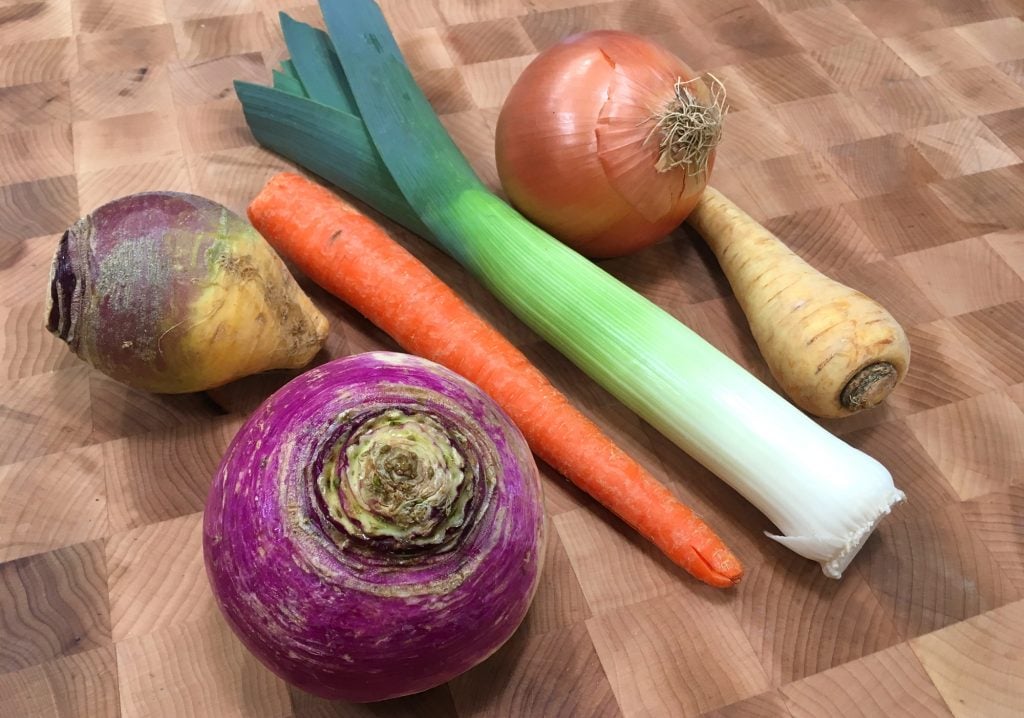
Cook the onions and garlic in the oil in a heavy stock pot or Dutch oven until softened 4-6 minutes.
Cook the onions and garlic in the lard or butter until softened, 4-6 minutes. Add the lamb, herbs, barley, split peas and salt. I tie my herbs with a bit of twine for easy removal later. That’s entirely optional.

Add the broth, bring to a boil, reduce the heat to low, cover and simmer for 2 hours. Skim off any foam.
Add the carrot, turnip, rutabaga and parsnip. Simmer for another hour.
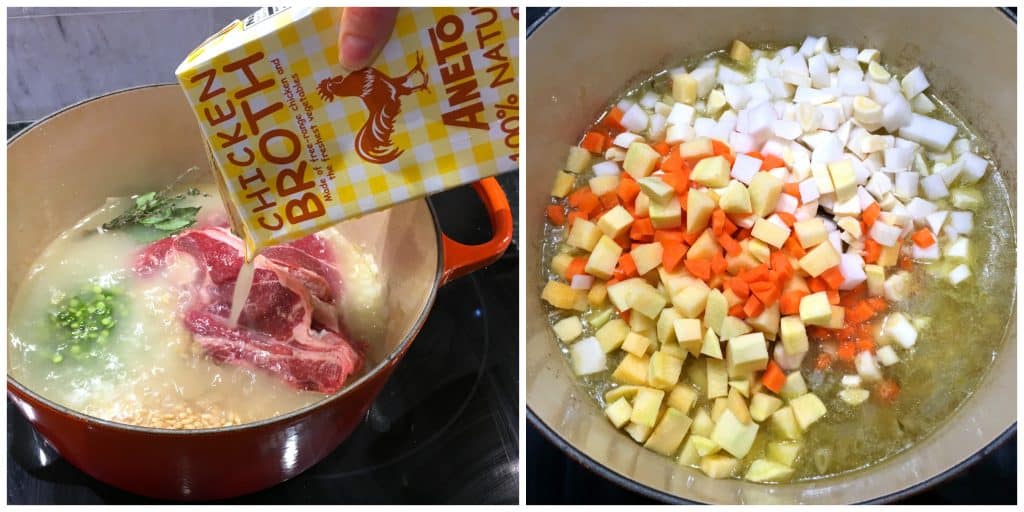
Remove the bay leaves and thyme sprigs. Remove the meat, shred it and discard the bones.
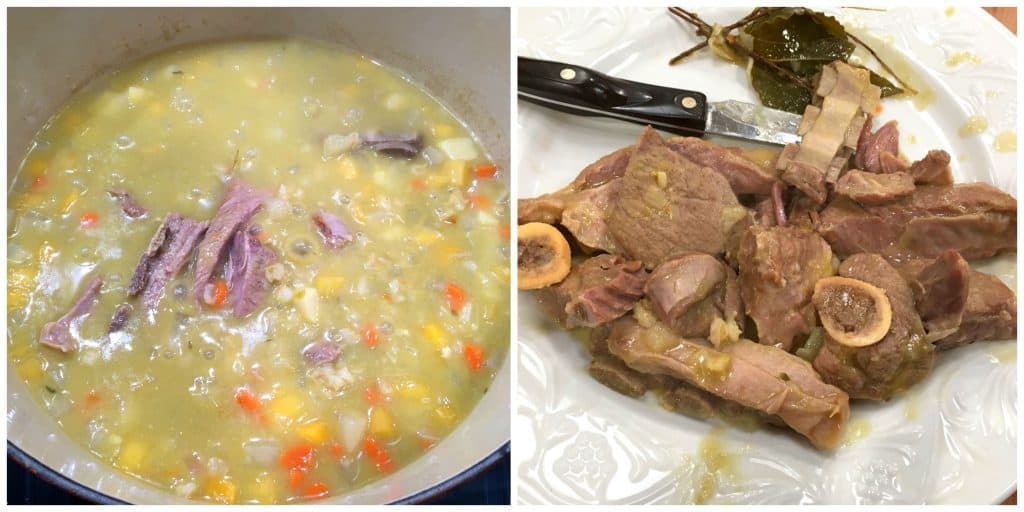
Return the shredded meat to the pot along with the leek and cabbage. Simmer for another 30 minutes. Add salt to taste.
We like this soup on the thick side, almost a stew. If you prefer the soup a bit thinner, add some more broth.

Serve garnished with fresh chopped parsley.
Enjoy!
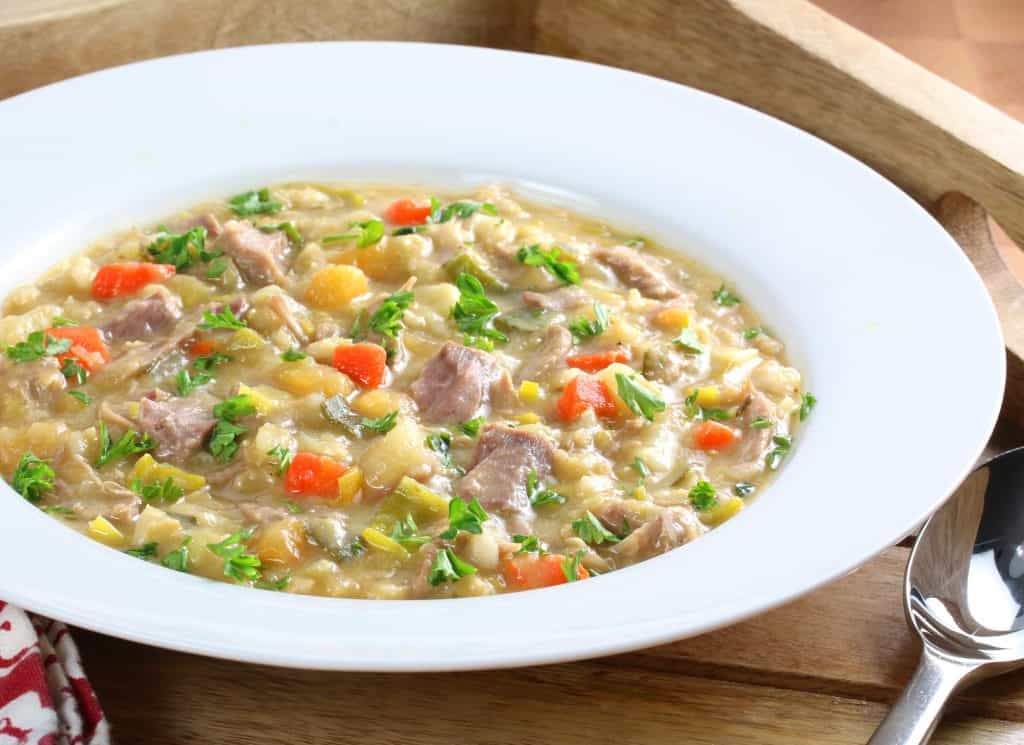
For more Scottish recipes be sure to try my:
- Dundee Cake
- Scottish Shortbread
- Millionaire Shortbread
- Scotch Eggs
- Cullen Skink
- Fish and Chips
- Bangers and Mash
- Scottish Barley Pudding
Save This Recipe
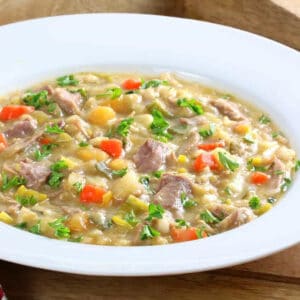
Traditional Scotch Broth
Ingredients
- 1 1/2 pounds lamb shoulder or shanks (or beef with bones)
- 2 tablespoons quality lard or butter
- how to make lard (it's super easy, click link for my tutorial!)
- 1 medium yellow onion, diced
- 3 cloves garlic, minced
- 1/2 cup pearl barley
- 1/3 cup dried green split peas
- 4 sprigs thyme
- 2 bay leaves
- 1 teaspoon salt
- 6 cups quality chicken broth
- homemade chicken broth (click link for recipe)
- 1 large carrot, diced
- 1 turnip, peeled and diced
- 1 rutabaga, peeled and diced
- 1 parsnip, peeled and diced
- 1/2 cup shredded green cabbage
- 1 medium leek, chopped, rinsed and drained
- fresh chopped parsley for garnish
Instructions
- Cook the onions and garlic in the lard or butter until softened, 4-6 minutes. Add the lamb, herbs, barley, split peas, salt and broth. Bring to a boil, reduce the heat to low, cover and simmer for 2 hours. Skim off any foam. Add the carrot, turnip, rutabaga and parsnip. Simmer for another hour.
- Remove the bay leaves and thyme sprigs. Remove the meat, shred it and discard the bones. Return the shredded meat to the pot along with the leek and cabbage. Simmer for another 30 minutes. Add salt to taste. I like this soup on the thick side, almost a stew. If you prefer the soup a bit thinner, add some more broth.Serve garnished with fresh chopped parsley.
Nutrition
Originally published on The Daring Gourmet March 18, 2018



















You must be joking – Spanish chicken stock cubes?? Lamb or mutton, preferably on the bone!! Back in the 1950’s in Glasgow we had never heard of stock cubes – especially Spanish chicken!!
Make it properly. I can only assume that you’re from America.
And I can only assume you never learned to read properly. Or have a habit of seeing things that aren’t there. “Stock cubes”? There’s no mention of that anywhere in my blog post or recipe. Cheers.
May I cook the entire stew and serve the next day?
Hi Beatrice, yes you sure can! The barley has a tendency to expand and absorb liquid so you may just need to add a little additional liquid the next day if it’s too thick.
Followed the recipe exactly and it was wonderful! My family loved it, will make it again this week. Thank you for your recipes and the history behind each.
Thank you so much, Kerry, I’m thrilled you enjoyed it and appreciate the compliment!
This is one of the best recipes I have tried, and is delicious. I buy lamb bones from the butcher and cook them until the meat is falling off the bone. I then pull off and dice the meat and some fat. This way I get the best of both, lamb bones are much cheaper than lamb shoulder or shank as an added bonus the broth is so good. I make this at least twice a month.
Thank you so much, Mary, I appreciate the feedback and am thrilled that this has become a regular!
Scotch Broth was a standard cold weather meal when I was growing up! Fond memories of thawing my hands out on a steaming mug of this! lol Now I live in the Caribbean where it rarely drops to cool enough temps to enjoy soup…HOWEVER…come Rainy season (which is fast approaching!) Now that I have found this recipe, I will be looking forward to a bowlful of this as I sit and watch it pouring (think Monsoon style weather!) outside !! Can hardly wait, (I will have to order the lamb from the mainland as we have none here.
Can I substitute yellow split peas for the green split peas? I have only the yellow ones in my larder right now, and its still soup season until the end of May in my books!
Hi Jen, yes you can.
As a Scot there is no way I’d use chicken stock for scotch broth. Mutton stock is traditional but hard to find these days so some kind of lamb is the next best thing.
Hi Elda, lamb broth is likewise hard if not impossible to find, so chicken broth is the next best thing.
Delicious, stick to your ribs food! This recipe is definitely a keeper. I followed the recipe to the letter. No substitutions. A very satisfying meal. Thank you.
I’m so glad you enjoyed it, Susan, thank you!